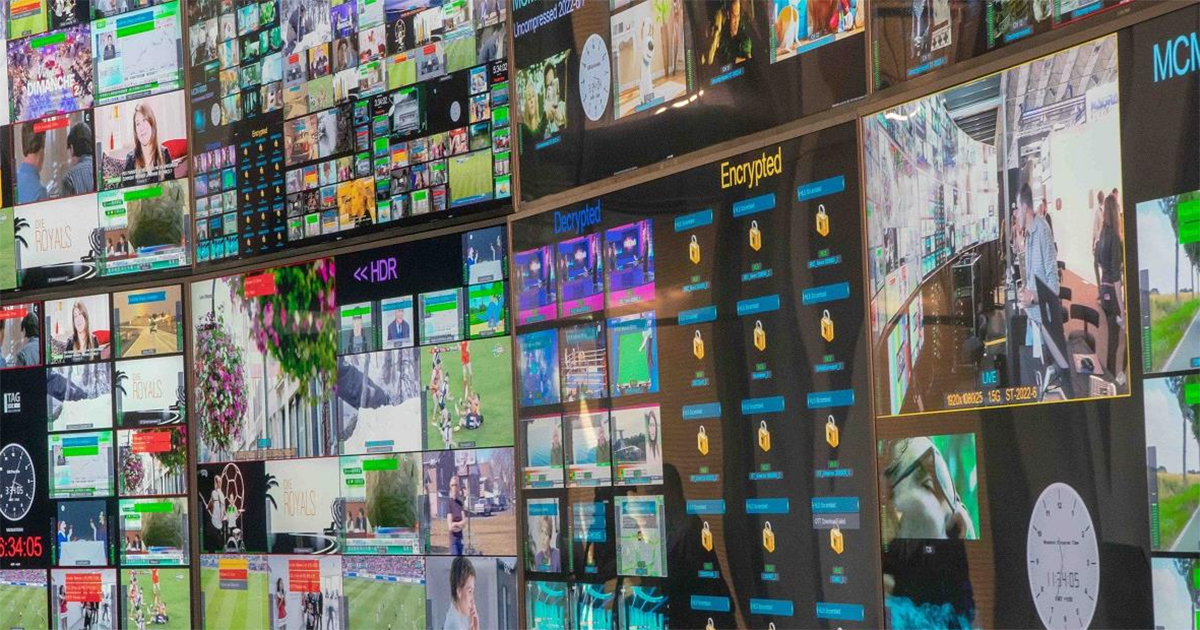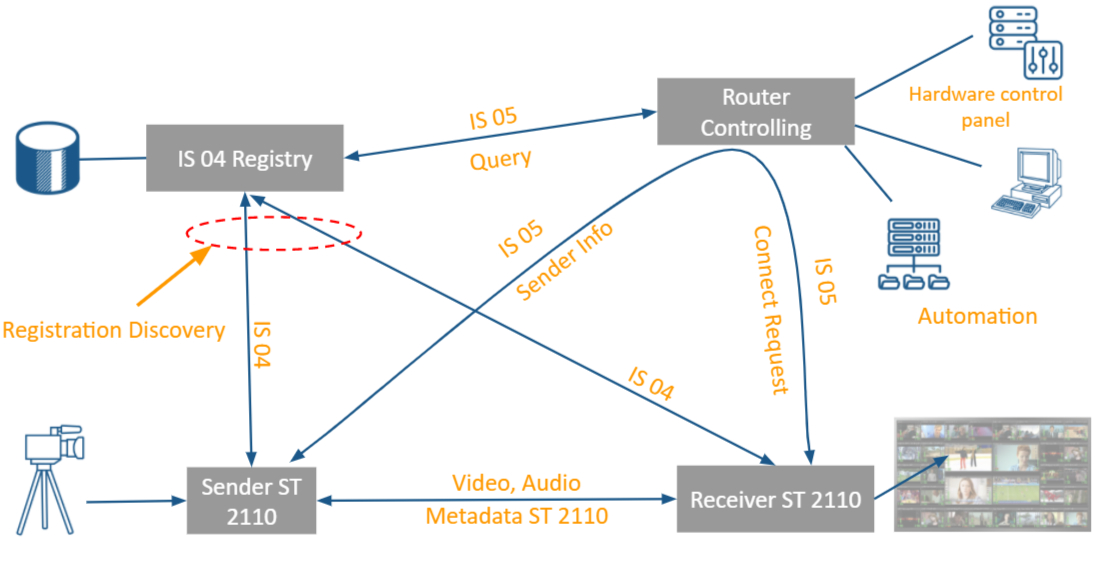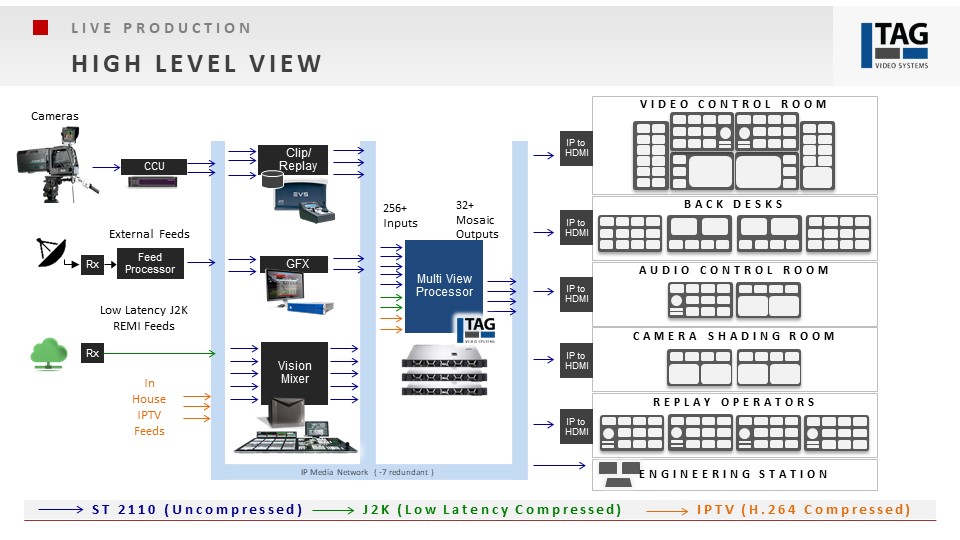
BY PAUL BRISCOE, CHIEF ARCHITECT, TAG VIDEO SYSTEMS
The SMPTE ST 2110 Professional Media Over Managed IP Networks suite of standards provides an excellent toolset for the evolution of live production systems, but a transport standard alone is no longer sufficient to support modern IP-based media workflows.
In SDI systems, signal routing was very straightforward and performed in the same manner used since the advent of television based on crosspoint telephone switching. In this architecture, the control system managing the switching recognizes sources and destinations only as physical switch ports and has no need to know anything more about streams or endpoints. The ST 2110 model is vastly different.
The ST 2110 model is based on senders and receivers of streams, with packets switched in a network fabric, transaction protocols used to facilitate stream routing, and the user metaphor of a “matrix” abstracted. Because so many formats can be supported by the same protocols, essential metadata is required for a receiver to consume and correctly interpret sources.
Routing control systems as offered by SDI router vendors could, of course, be adapted to create such a control system, but not without challenges. While the architecture of panels and a centralized controller remain useful, the backend of such a system is very specific to the vendor’s specific hardware implementation. Moreover, it has no awareness of anything beyond the matrix metaphor, which is reality in its world, but entirely emulated in IP.
“NMOS sits in that sweet spot where standards need to be. It does what it needs to do, and it does not do any more.”
If each vendor were to implement its own solution for routing control in the ST 2110 environment, the process would involve creation and use of device and stream metadata, as well as understanding of IP addresses and other parameters. The end result would be unique to that vendor.
If the vendor also built the switch fabric and endpoints, this approach might be fine. But the switches now used in ST 2110 environments are IT commodity platforms, and multi-vendor interoperability is a must if media organizations are to realize the freedom to choose best-of-breed systems for their IP-based workflows.
What is needed to ensure interoperability? A companion suite of tools — specifications and recommendations — that augment the incredible strength and flexibility of the ST 2110 suite by addressing device management, signal routing, and allied services.
Step Forward NMOS: Critical Recs and Specs Fill the Gap
While ST 2110 covers the transport of video, audio and ancillary data as RTP streams, it does not have an inherent mechanism for directing those streams. Together, the Networked Media Open Specifications (NMOS) developed by the Advanced Media Workflow Association (AMWA) and TR-1001 from the Joint Task Force on Networked Media (JT-NM) address this need, supporting interoperable discovery and connection of the devices sending and receiving these streams.
Developed in parallel with the development of ST 2110, NMOS originally comprised two pieces, IS-04 and IS-05, intended to support two critical capabilities. The first of these is discovery registration, outlined in IS-04, or the identification and association of video, audio and metadata streams.

The second piece is connection management, outlined in IS-05, which effectively directs connections and traffic between stream senders and receivers in a transport- and format-independent way. Together, these two specifications allow media organizations to work with various IP streams much as they worked with streams in the SDI realm. At this point in the evolution of NMOS, any reference to the specifications typically can be assumed to mean IS-04 and IS-05, which remain the core specifications within the suite.
TAG Video Systems’ TR-1001 plays an important role here in that it provides technical recommendations for creating network environments that effectively support plug-and-play integration of new equipment from various vendors. Covering various aspects of how ST 2110, Precision Timing Protocol (PTP), and NMOS should be used for engineered networks such as those implemented in media facilities, it prevents common issues and eases technical support requirements for media organizations as they move toward IP.
NMOS: What It Does and How
NMOS is an evolving set of specifications for services that enable not just the capability equivalence of SDI crosspoint-like routing, but the entire flexibility of ST 2110. The suite provides for a common point of device registration where all the metadata for all devices is kept; a discovery service to find devices and associated registration service; a structured and extensible metadata format (use of which is specified in the ST 2110 documents); a connection management protocol; and additional media meta-services.
NMOS thus delivers two key benefits. It removes the problem of incompatibility of router matrices between manufacturers, and it aggregates into one place the entire view of the routing system, regardless of device or switch vendor.
Today, a media organization typically selects a router and control system together. If new or additional routing requirements emerge, and the organization selects a different vendor (due to technology, price and/or availability changes), it is necessary to use a protocol-translating device (or series of them) to bridge new and existing systems.
In addition to presenting configuration and management issues, the use of “little boxes” to solve this problem introduces single points of failure into critical systems, which is never a good idea. Over time, this approach is likely to become unwieldy. For an organization taking advantage of NMOS, however, control of the switch is democratized, and any control system — manual or automatic — participates in the network in the same way.
Because NMOS provides a complete view of the routing system and all devices, any control system can leverage NMOS to use the system however the end user desires. As a result, control system vendors have greater freedom to innovate and enrich their offerings, to take greatest advantage of ST 2110 and IP, and to offer system-wide capability regardless of infrastructure.
The Specification Suite So Far
Various specifications within the NMOS suite work together as building blocks to address different requirements. The JT-NM industry roadmap incorporates NMOS, and TR-1001-1 specifically mandates NMOS IS-04 and IS-05 specifications.
These two specifications are widely adopted now, while newer specifications — IS-06, IS-07, IS-08, and IS-09 — are being tested and implemented as the industry moves down the road toward fully interoperable IP infrastructure. Before being formally published as an Interface Specification (IS), elements of the NMOS suite are typically categorized and treated as Best Current Practice (BCP).
Again, IS-04 covers discovery and registration. By allowing control and monitoring applications to find resources such as nodes, devices, senders, receivers, sources, and flows on a network, it enables greater automation and simplifies setup and configuration of networked systems.

IS-05 covers connection management, providing a transport-independent way of connecting media modes. The specification removes dependencies on proprietary routing protocols, offers a foundation for working with new stream formats, and supports dynamic deployment and configuration.
IS-05 can (but does not need to) take advantage of Session Description Protocol (SDP) for describing media details, transport addresses, and other metadata. Because SDP is included in ST 2110 for describing RTP streams, and because ST 2110-compliant senders and receivers use the protocol, it simply makes sense for IS-05 to account for it.
IS-06 focuses on the “northbound” API of the network controller to discover the network topology, control movement of flows on the network, ensure adequate bandwidth for those flows, and ensure network security by allowing only authorized flows, senders, and destinations. All of these capabilities combine to prevent conditions that can lead to packet loss and the corruption of media flows.
Why NMOS Now?
Without NMOS, media organizations remain tied to an array of proprietary protocols and bespoke methods of connecting devices and moving streams across their IP infrastructure. They have no guarantee that any two products from different vendors will interoperate, and they face a challenge each time they ask a product to do something new or do the same job in a new place.
The interoperability enabled by NMOS is a prerequisite to working with best-of-breed products across a media workflow, and it is essential to keeping up with innovation and change without significant headaches and cost. Because NMOS is standards-based, it allows new hires with industry experience to hit the ground running rather than spend time training on proprietary protocols.
The specifications suite also reduces the need for manual intervention. As an organization deploys resources and stands up a system under automation, NMOS will discover and operationalize those resources as soon as they appear. This model makes it easy to take advantage of new products and features as they hit the market.
NMOS sits in that sweet spot where standards need to be. It does what it needs to do, and it does not do any more. The specifications provide a framework in which to innovate and adapt as standards grow and new capabilities and opportunities arise.


Discussion
Responses (1)